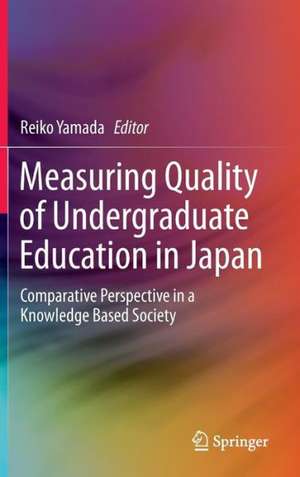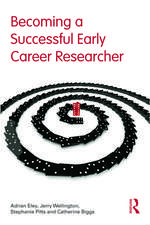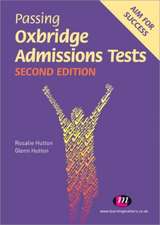Measuring Quality of Undergraduate Education in Japan: Comparative Perspective in a Knowledge Based Society
Editat de Reiko Yamadaen Limba Engleză Hardback – 5 mai 2014
The book first explores the forces of globalization that have resulted in Japanese universities emphasizing student learning outcomes. Next, it examines how Japanese higher education has learned from the experience of the U.S., whose higher education reform has been regarded as a model for Japan. The book explains why quality assurance for teaching and learning has become important for all Japanese higher education institutions.
Higher Education on a global basis is now facing a great issue. In order to help students in a competitive global market, universities need to become more teaching-and-learning-centered and develop more internationalized curricula. This book provides comparative views for cultural and structural similarities and differences in higher education in two countries which could explain significant differences in the gains students make in college. It will help readers understand not only how student learning outcomes can be measured, but why universities throughout the world must continually strive to become world-class institutions.
| Toate formatele și edițiile | Preț | Express |
|---|---|---|
| Paperback (1) | 637.78 lei 6-8 săpt. | |
| Springer Nature Singapore – 3 sep 2016 | 637.78 lei 6-8 săpt. | |
| Hardback (1) | 643.99 lei 6-8 săpt. | |
| Springer Nature Singapore – 5 mai 2014 | 643.99 lei 6-8 săpt. |
Preț: 643.99 lei
Preț vechi: 757.63 lei
-15% Nou
Puncte Express: 966
Preț estimativ în valută:
123.22€ • 128.67$ • 101.76£
123.22€ • 128.67$ • 101.76£
Carte tipărită la comandă
Livrare economică 16-30 aprilie
Preluare comenzi: 021 569.72.76
Specificații
ISBN-13: 9789814585804
ISBN-10: 9814585807
Pagini: 244
Ilustrații: XXI, 221 p. 14 illus.
Dimensiuni: 155 x 235 x 20 mm
Greutate: 0.52 kg
Ediția:2014
Editura: Springer Nature Singapore
Colecția Springer
Locul publicării:Singapore, Singapore
ISBN-10: 9814585807
Pagini: 244
Ilustrații: XXI, 221 p. 14 illus.
Dimensiuni: 155 x 235 x 20 mm
Greutate: 0.52 kg
Ediția:2014
Editura: Springer Nature Singapore
Colecția Springer
Locul publicării:Singapore, Singapore
Public țintă
ResearchCuprins
Preface.- Part I: Trend of Quality Assurance of Higher Education in Comparative Perspective.- Introduction: Giving Dimension and Direction of Measuring Quality of Undergraduate Education in Japan.- Higher Education Policy Worldwide and Quality Assurance in Knowledge Based Society.- Structural Transformation of Japanese Higher Education: Adapting to Meet Challenges Posed by Globalization and Market Economy.- Part II: Measuring Student Learning Outcomes.- Measurement Trend of Learning Outcomes in the United States.- Measurement for the learning Outcomes: The Role of JCIRP for Assessing Student Learning.- Learning Outcomes of College Students in Japan: Comparative Analysis of between and within University.- The Possibility and Challenges of a Large Scale Continuous Student Survey System: Through Analysis of JCIRP data.- Quality Assurance of Teaching and Learning and Institutional Research.- Part III: Quality Assurance of Undergraduate Education: Comparative Analysis between USA and Japan.- What Kind of Issues and Challenges Does Japanese Undergraduate Education Face?: Comparative Analysis between USA and Japan.- Development of first-year Experience in Higher Education: Comparative Study between US and Japan.- Today’s First-year Students and the Institutional Practice in the First College Year: of Japanese Universities.- Issues of Educational Articulation between University and High School: Comparative Analysis between USA and Japan.- Conclusion.
Notă biografică
Reiko Yamada is a professor at Faculty of Social Studies, Doshisha University, and a Director of Center for Higher Education and Student Research. She is the leading person in this field in Japan. Her researches on Japanese student development and learning outcomes based on college impact theory are well recognized in not only in Japan but also in the United States and Korea. The author developed the self-reported student surveys (JCIRP) from 2004 which are comparable with US surveys so called CIRP developed by HERI (UCLA) and 130,000 students participated in the JCIRP by the end of 2013.
Textul de pe ultima copertă
This book explores how the global trend of quality assurance in higher education is related to the boom of measuring learning outcomes in Japan. It also presents a comparative study in higher education policy between Japan and the US, examining how both countries have reacted to the demands of globalization. This comparative view will help readers understand the present issues Japanese higher education faces and grasp the commonalties and differences between American and Japanese higher education.
The book first explores the forces of globalization that have resulted in Japanese universities emphasizing student learning outcomes. Next, it examines how Japanese higher education has learned from the experience of the U.S., whose higher education reform has been regarded as a model for Japan. The book explains why quality assurance for teaching and learning has become important for all Japanese higher education institutions.
Higher Education on a global basis is now facing a great issue. In order to help students in a competitive global market, universities need to become more teaching-and-learning-centered and develop more internationalized curricula. This book provides comparative views for cultural and structural similarities and differences in higher education in two countries which could explain significant differences in the gains students make in college. It will help readers understand not only how student learning outcomes can be measured, but why universities throughout the world must continually strive to become world-class institutions.
The book first explores the forces of globalization that have resulted in Japanese universities emphasizing student learning outcomes. Next, it examines how Japanese higher education has learned from the experience of the U.S., whose higher education reform has been regarded as a model for Japan. The book explains why quality assurance for teaching and learning has become important for all Japanese higher education institutions.
Higher Education on a global basis is now facing a great issue. In order to help students in a competitive global market, universities need to become more teaching-and-learning-centered and develop more internationalized curricula. This book provides comparative views for cultural and structural similarities and differences in higher education in two countries which could explain significant differences in the gains students make in college. It will help readers understand not only how student learning outcomes can be measured, but why universities throughout the world must continually strive to become world-class institutions.
Caracteristici
Offers a comparative study of empirical data of Japanese and US college students Provides up-to-date information about Japanese higher education policy toward knowledge based society and the globalization movement Shares good institutional practices of quality assurance of undergraduate education from Japan












